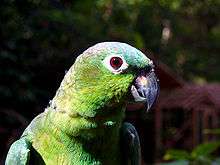Northern mealy amazon
The northern mealy amazon or northern mealy parrot (Amazona guatemalae) is among the largest parrots in the genus Amazona, the amazon parrots. It is a mainly green parrot with a total length of 38–41 cm (15–16 in). It is endemic to tropical Central America. This species and the southern mealy amazon were previously considered conspecific. Some taxonomic authorities (including the American Ornithological Society, continue to lump them together.
| Northern mealy amazon | |
|---|---|
 | |
| Scientific classification | |
| Kingdom: | Animalia |
| Phylum: | Chordata |
| Class: | Aves |
| Order: | Psittaciformes |
| Family: | Psittacidae |
| Genus: | Amazona |
| Species: | A. guatemalae |
| Binomial name | |
| Amazona guatemalae (PL Sclater, 1860) | |
Range, common names and races
The northern mealy amazon occurs in tropical Central America. It frequents humid to semi-humid forest (only rarely in deciduous forest) and plantations. In regions dominated by open/dry habitats it is restricted to gallery forest or completely absent.
Two subspecies have been described and these have alternative common names that are used frequently in aviculture:
Description
.jpg)
The northern mealy amazon has a total length of about 38–41 cm (15–16 in)[2][3] and weighs 540–700 g (19–25 oz). It has a relatively short and squarish tail, as do the other members of the Amazona genus.
The northern mealy amazon is mainly green. The back and nape often have a whitish tinge; almost as if it had been covered in a thin layer of flour ("meal"; hence its name). The distal half of the tail is paler and more yellow than the basal half, thus resulting in a distinctly bi-colored look. In flight it shows a bluish-black trailing edge to the wing and a conspicuous red speculum. Occasionally a few yellow feathers are apparent on the top of the head and it has a bluish-tinged crown. The maroon to orange eyes (which typically appear dark from a distance) are surrounded by a relatively broad white eye-ring of bare skin.
Behavior
The northern mealy amazon is social and can be found in pairs or in large flocks. They are even known to interact with other parrots, such as macaws. They are usually quiet but can be loud at dusk and dawn.
Breeding
After northern mealy amazons reach sexual maturity they usually form monogamous relationships with a single partner. Each year courtship usually begins in early spring, and the female will usually lay three or four white eggs in a tree-cavity nest. The female incubates the eggs for about 26 days. The male regurgitates food for the female during the incubation period, and later for the chicks in the nest as well. The chicks leave the nest about 60 days after hatching.[4]
Status and conservation
It is fairly common in most of its range, but has declined locally due to habitat loss and trapping for the wild parrot trade. Trafficking of the birds (as for exotic pets) is illegal in many nations, but the species are still smuggled into the United States from Mexico. The northern mealy amazon sometimes feeds on human crops (especially corn) and may be considered a crop pest.
References
- BirdLife International (2012). "Amazona guatemalae". IUCN Red List of Threatened Species. 2012. Retrieved 26 November 2013.CS1 maint: ref=harv (link)
- Birds of Venezuela by Hilty (2003) ISBN 0-691-09250-8
- The Birds of Ecuador vol. 2 by Ridgely & Greenfield (2001) ISBN 0-7136-6117-8
- Alderton, David (2003). The Ultimate Encyclopedia of Caged and Aviary Birds. London, England: Hermes House. p. 232. ISBN 1-84309-164-X.
- Sholty, Kathleen. "Amazona farinosa (mealy parrot)." Animal Diversity Web. University of Michigan Museum of Zoology. 2006.
- A Guide to the Parrots of the World by Juniper & Parr (1998) ISBN 90-74345-16-6
- A Guide to Birds of Mexico and Northern Central America by Howell & Webb (1995) ISBN 0-19-854013-2
